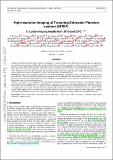High-resolution Imaging of Transiting Extrasolar Planetary systems (HITEP). II. Lucky Imaging results from 2015 and 2016
Abstract
Context. The formation and dynamical history of hot Jupiters is currently debated, with wide stellar binaries having been suggested as a potential formation pathway. Additionally, contaminating light from both binary companions and unassociated stars can significantly bias the results of planet characterisation studies, but can be corrected for if the properties of the contaminating star are known. Aims. We search for binary companions to known transiting exoplanet host stars, in order to determine the multiplicity properties of hot Jupiter host stars. We also characterise unassociated stars along the line of sight, allowing photometric and spectroscopic observations of the planetary system to be corrected for contaminating light. Methods. We analyse lucky imaging observations of 97 Southern hemisphere exoplanet host stars, using the Two Colour Instrument on the Danish 1.54m telescope. For each detected companion star, we determine flux ratios relative to the planet host star in two passbands, and measure the relative position of the companion. The probability of each companion being physically associated was determined using our two-colour photometry. Results. A catalogue of close companion stars is presented, including flux ratios, position measurements, and estimated companion star temperature. For companions that are potential binary companions, we review archival and catalogue data for further evidence. For WASP-77AB and WASP-85AB, we combine our data with historical measurements to determine the binary orbits, showing them to be moderately eccentric and inclined to the line of sight and planetary orbital axis. Combining our survey with the similar Friends of Hot Jupiters survey, we conclude that known hot Jupiter host stars show a deficit of high mass stellar companions compared to the field star population; however, this may be a result of the biases in detection and target selection by ground-based surveys.
Citation
Evans , D F , Southworth , J , Smalley , B , Jørgensen , U G , Dominik , M , Andersen , M I , Bozza , V , Bramich , D M , Burgdorf , M J , Ciceri , S , D'Ago , G , Jaimes , R F , Gu , S -H , Hinse , T C , Henning , T , Hundertmark , M , Kains , N , Kerins , E , Korhonen , H , Kokotanekova , R , Kuffmeier , M , Longa-Peña , P , Mancini , L , MacKenzie , J , Popovas , A , Rabus , M , Rahvar , S , Sajadian , S , Snodgrass , C , Skottfelt , J , Surdej , J , Tronsgaard , R , Unda-Sanzana , E , Essen , C V , Wang , Y-B & Wertz , O 2018 , ' High-resolution Imaging of Transiting Extrasolar Planetary systems (HITEP). II. Lucky Imaging results from 2015 and 2016 ' , Astronomy & Astrophysics , vol. 610 , A20 . https://doi.org/10.1051/0004-6361/201731855
Publication
Astronomy & Astrophysics
Status
Peer reviewed
ISSN
0004-6361Type
Journal article
Collections
Items in the St Andrews Research Repository are protected by copyright, with all rights reserved, unless otherwise indicated.

